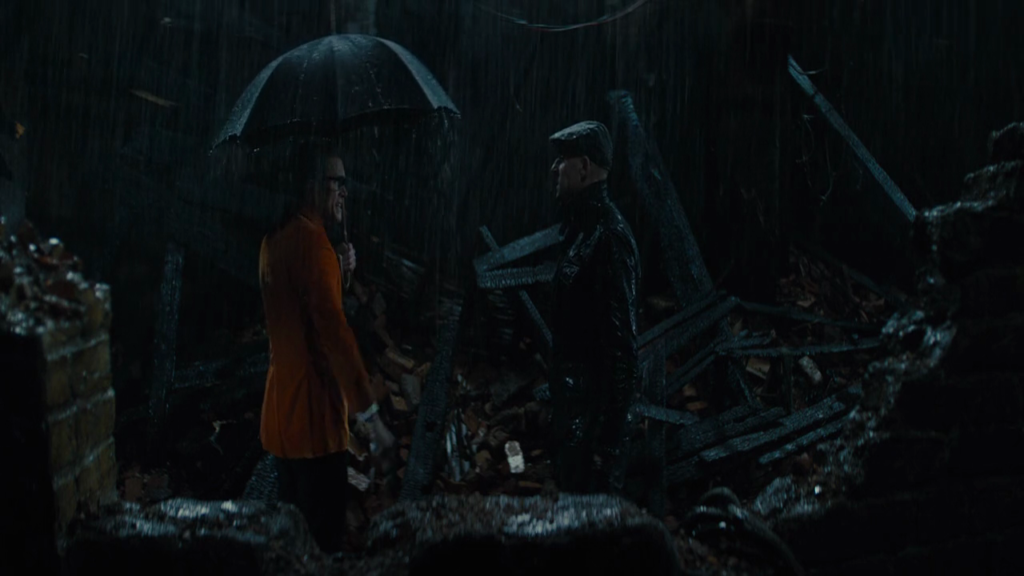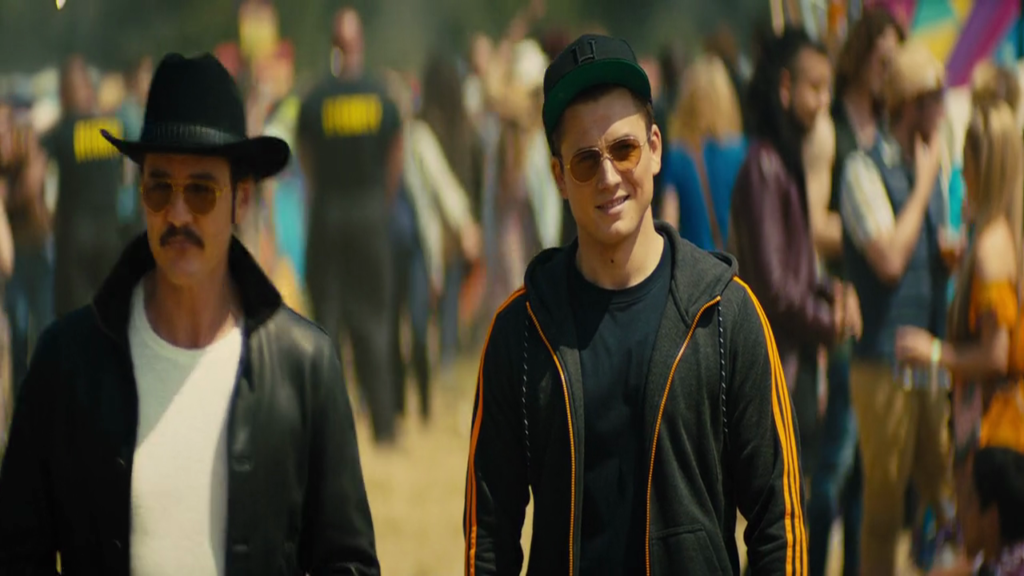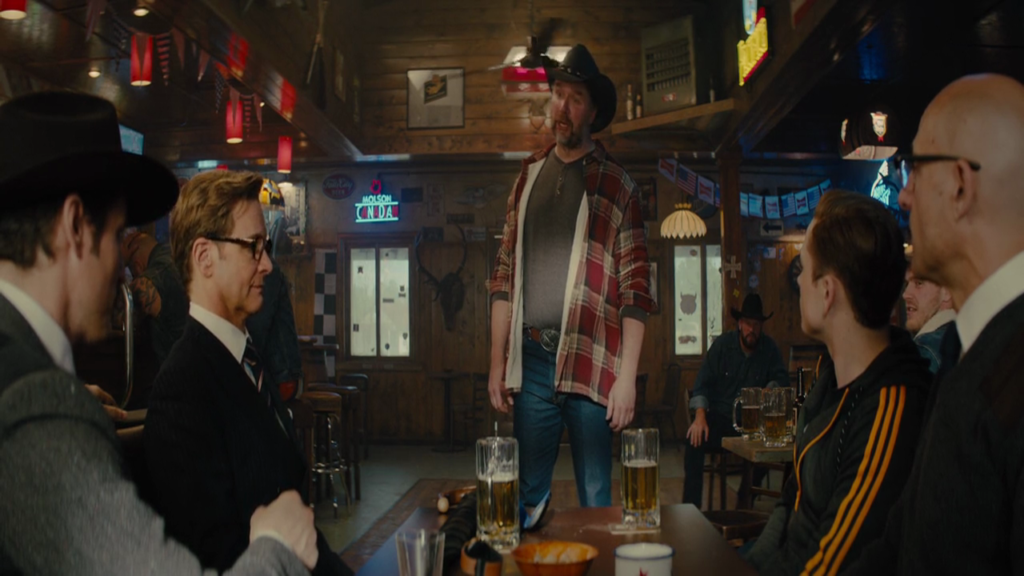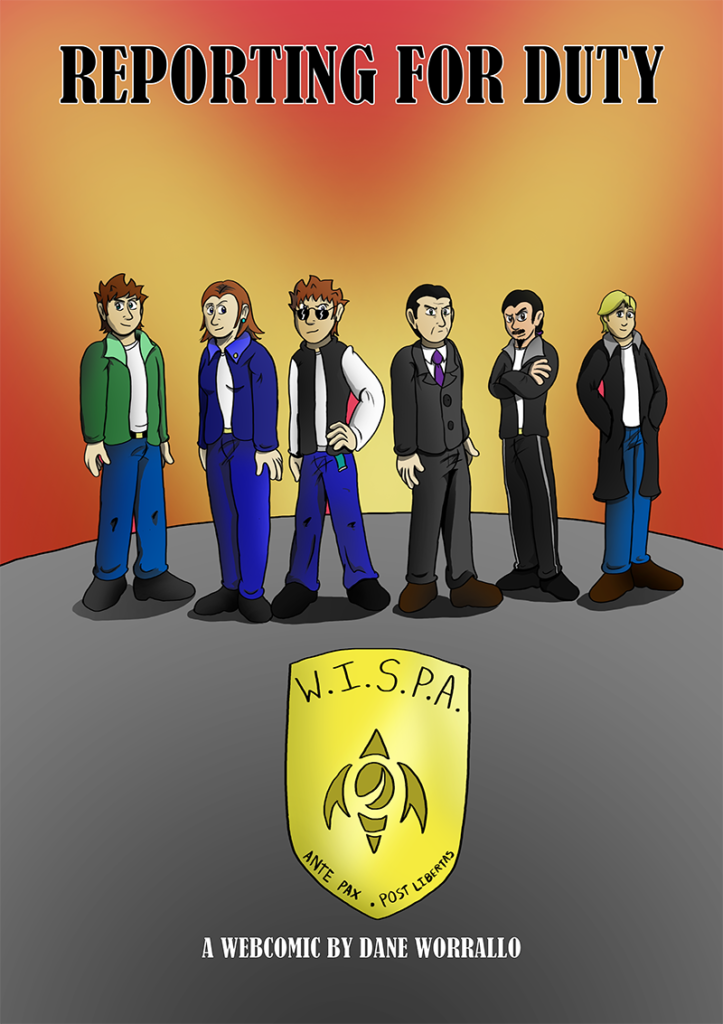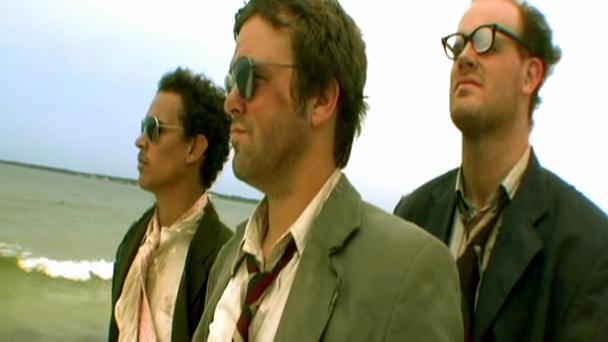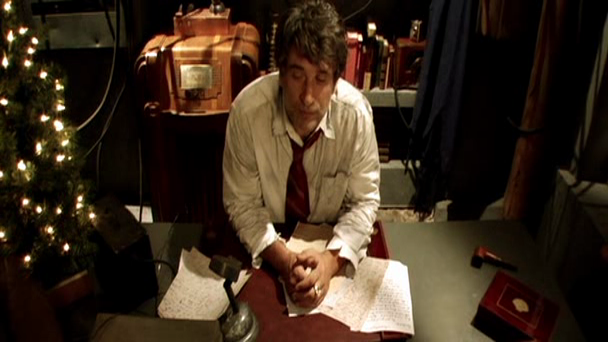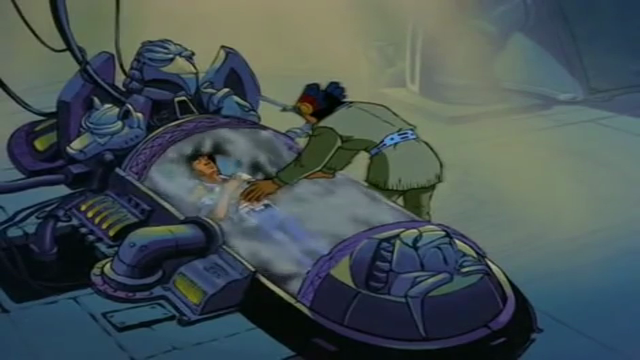-
#361 – Kingsman: The Golden Circle (2017)
Kingsman: The Golden Circle (2017)
Film review #361
Director: Matthew Vaughn
SYNOPSIS: When an attack on the secret agency Kingsman leaves the entire organisation in ruins and agent Galahad (Eggsy) and Merlin as the only survivors, they enact the doomsday protocol and head out to Kentucky to seek out assistance. They discover the Statesmen, a secret agency like their own, and the two must join forces to stop a mysterious organisation known as the “Golden Circle”, which is holding the world hostage by infecting drugs with a disease that can only be cured with the antidote being held by them…
THOUGHTS/ANALYSIS: Kingsman: The Golden Circle is a 2017 spy film and the sequel to the 2014 Kingsman film. The film starts off re-introducing Eggsy, the protagonist of the first film, and throwing him straight into an action sequence involving a high speed fight scene through the streets of London. It is a strong start that delivers precisely what you would expect from the film, as well as setting up the plot of the rest of the film. Everything changes however, when an attack targeting all of the Kingsman agents and assets leaves the entire agency wiped with Eggsy and intelligence asset Merlin as the only survivors. The film starts off re-introducing all the familiar concepts and characters, and to destroy them all in the blink of an eye certainly raises the stakes, but in doing so leaves no room for the agency to develop or for us to learn more about it. The plot on the whole is fairly straightforward and follows the typical structure of a spy film, but blends in some contemporary twists and comedy as did its predecessor to freshen up the genre. Unfortunately, the problems that the first film had still persists in the sequel: namely the inconsistency of tone and a wayward idea of what the film wants to be. Whether a serious spy film, a spoof of said films, or something else, it oscillates between these objectives and as a result feels a little disjointed. However, I think it improves on these issues compared to its predecessor, and the more over-the-top characters and story help reinforce the notion that the film is essentially a bit of not-so-serious entertainment.
After Kingsman is essentially wiped out, Merlin and Galahad/Eggsy learn that the agency’s “doomsday protocol” involves an American whiskey brewer in some way. They travel out to Kentucky where they find it is the home of the “Statesmen”: the U.S. equivalent of Kingsman, They agree to work together to find who was behind the attack; a group calling themselves the “Golden Circle.” But that’s not all. It turns out they also rescued Harry, the Kingsman agent who was shot and seemingly killed in the first film. However, he has lost his memory, and part of the film revolves around trying to reclaim it. There’s actually quite a lot of story going on in The Golden Circle, and it equates to a film with a runtime of nearly two and a half hours. I think this could have been reduced to make it run a bit more smoothly, as there a lot of elements that aren’t too necessary for the story. The new characters barely make any impact on the film, and as the film’s aim is to expand the world with this new agency, this failure is rather significant. On the other hand, there’s some good roles for the villains, and the bizarre role that Elton John has helps spice things up a little.
The Golden Circle retains the style of the original in terms of the action sequences, with the over-the-top and entertaining fights and chases that not only are in keeping with the original, but make them even more ambitious and over-the-top. The original had this element of a normal young man being brought into this extraordinary world and all the conflicts that arose from it, whereas this sequel starts off in the latter and never really comes down from it, creating a different feeling. In fact, the film builds on this and makes things even more over-the-top, introducing robot guards and dogs for the agents to fight. The effects however, are pretty consistent, and give the visuals a definite flair and impact that compliment the excessive and silly setups without them looking cheap or tacky. Overall, Kingsman: The Golden Circle keeps the mix of comedy and action that made the first film successful, while also doubling down on the more over-the-top elements. The returning characters and ideas are worked through more thoroughly quite well, but the new characters and elements are often overshadowed and play an ever-diminishing role. It still suffers from an inconsistent tone with regards to what it is aiming to be, but makes some strides to improve on it. It’s more silly action and entertainment, with an occasional and clever swipe at American culture that all adds up to another worthwhile bit of entertainment.
-
#360 – Kingsman: The Secret Service (2014)
Kingsman: The Secret Service (2014)
Film review #360
Director: Matthew Vaughn
SYNOPSIS: When Eggsy, a troubled young man ends up in trouble with the police and practically everyone else, he calls a number that was given to him when his Father died if he was ever in trouble. This leads to him being released and meeting Harry Hart, a seemingly refined and upper-class gentleman. However, it turns out Harry is part of a secret agency called the Kingsman, which Eggsy’s Father was also a part of, which fights crime and preserves world peace. Harry chooses Eggsy as a candidate to join the Kingsman, but he must undergo a series of trials to prove he is worthy, and meanwhile a rich tycoon is plotting a global catastrophe that the agency must try to stop before it is too late…
THOUGHTS/ANALYSIS: Kingsman: The Secret Service is a 2014 spy film about a secret service that independently preserves world peace. The film starts off (after a brief introduction scene set twenty years prior) introducing Eggsy, a young man who has had a troubled upbringing, having lost his Father at a young age and his Mother being in a relationship with a local mobster. Eggsy gets into trouble after stealing a car and ramming it into a police car to allow his friends to escape. When at the police station, he uses his one phone call to call a number on the back of a medal awarded to his Father when he died, which allowed him “one favour”. Eggsy walks out of the police station and is approached by Harry Hart, who got him released, and Eggsy learns that he is part of a secret service, like his Father, which helps to preserve world peace. Following the death of one of their agents, Harry nominates Eggsy as a candidate to replace him, and he begins his training to become a spy and a gentleman. The plot follows a recognisable story of an outcast who is taken into the high life and brings his own unique character into situations where it is not normally encountered, and where people discriminate against him for it. It is a story that has been told many times in cinematic history, and honestly is one that needs to be re-told: a similar story from the eighties featuring a young person in the same role is not going to have the same impact as Eggsy, as both face different problems respective to the times in which they grow up. There are a lot of similarities too, of course, but the key lies in the lead being relatable, and facing distinct, recognisable obstacles for them to overcome. With this in mind, Kingsman executes this story for the time it was made very well, and makes Eggsy a unique character that is a product of his time, and identifiable with the target audience. Sure, because of this the plot is a little predictable, but being a spy film it still finds a way to throw in enough twists, double-crosses, and surprises to make it gripping and entertaining. This is also important because as part of the comedy/spoof style of the film, it requires the viewer to be familiar with the tropes in order to play with and subvert them.
Another of Kingsman’s strengths is in it’s casting. Featuring a host of recognisable British actors gives the characters a certain powerful aura, which contrasts nicely to the relatively unknown Eggsy. Samuel L. Jackson and Mark Hamil round off the cast to give it an even wider recognisable appeal. The characters themselves fit neatly into their specific roles, again in keeping with the plot and the type of story it is telling, so there’s few surprises, but the performances make these characters come to life, and are full of personality. However, there are some surprises too, with the main villain Richmond Valentine (played by Jackson) being a entrepreneur billionaire with a lisp who dresses like Eggsy and who also cannot stand the sight of blood. Sometimes the film plays it straight as a spy film, while at other times it asserts itself more as a comedy or spoof of spy films, and there’s a lot of oscillation between the two that makes the tone of the film feel a little uneven at times. For example, the more comedic moments don’t go well with the gory violence present throughout, and trying to both play the film as a straight spy film and a comedic spoof of one, while also adding in the gory parts creates a confused tone that is never really resolved.
Another positive for the film lies in the action sequences, which, as mentioned, are often hyperviolent and gory, but are fast, fluid and undeniably entertaining, and that’s where the film’s biggest strength lies: it sometimes crosses genres which ends up leaving the film feeling a little muddled in terms of its detail, but it certainly is not boring. Even when the film is going through the motions regarding Eggsy’s incorporation into the unfamiliar world of the Kingsman, there’s enough work being done to set up the characters and setting to make it unique. Overall, while the film suffers from some inconsistency and a sometimes unclear sense of what it wants to be, it is a well executed, entertaining adventure that adds enough fresh content to a familiar story to make it relevant and appealing.
-
Webcomic series “W.I.S.P.A.” and “Sealers Stories” launching later this year.
This will be a long post, but I’ll start off with the heart of the matter first:
I will be launching my two webcomics: W.I.S.P.A. and Sealers Stories later this year!
Having finished writing my PhD (awaiting submission and examination) and accomplished what I wanted to do, I can turn my attention more to working on these two comics. It’s something I have always wanted to do, but I have never really shared or publicised, and it is definitely time to change that.
First, let me give some backstory on where this all started.
Drawing comics is something I have done since I was a kid, and was really all I wanted to do. I created and drew many different comics and characters growing up, and having access to the internet in 2003, I found out about the new world of webcomics, which I definitely wanted to get involved in. So in 2004 I started running three webcomics (yes, three) until 2007, totalling 100 strips for each. Being sixteen, it’s safe to say that the comics I did were a little naïve and haven’t aged well. In 2008 I started university studying fine art, which is a bit of a departure from my background in comics and illustration, and so my comic work was put on the back burner for a long while, and I wasn’t sure it would ever re-surface with my career going in a different direction.
In the beginning of 2016, with my PhD well underway, I just randomly had the urge to do something with my comics again. Being older and (debatably) wiser, I started planning out stories, ideas and characters old and new, and settled on two comics (more on those in a bit). Obviously my PhD had to occupy most of my time, and so I would work on my comics on the weekends or odd evenings, and I’ve slowly been plugging away at them, building a backlog of comics and properly planning out the story arcs for each.
W.I.S.P.A. (Worldwide Independent Spies and Professional Agents) is a comic I first came up with when I was around thirteen, and honestly hasn’t changed that much. It follows the work of a secret agency whose agents handle the extreme and unconventional assignments and operations nobody else is able or wants to. It’s a mixture of humour and action, and was one of the original three webcomics I ran from 2004 to 2007, and briefly restarted in 2011, after I finished my undergraduate degree. The basic idea has stayed quite consistent over the years (which is a novelty for me) and has always centred around the core team of six agents: Slick, Trent, Becki, Hotshot, Strafe and Tracker.
Sealers Stories is more difficult to pin down as to its origins. It’s a mixture of a number of comics, characters, stories and ideas I’ve been trying to work on ever since I was at least ten, consisting of a group of kids who end up with some special powers, and their resulting adventure. Some of the elements of Sealers Stories date back to that time (one character in particular), and the rest are a mix of two different webcomic ideas: one which I scrapped for the other, which was one of the original 100 webcomics run. It has been hard work putting these ideas I’ve had for the past twenty years into a story, but I feel happy with what I’ve managed to accomplish. As a result of all these influences, the content and characters is large and varied, but all weaves together to create a very particular and interesting setting, all the while focusing on the eight teenagers at the heart of the story: Alex, Vicky, Brad, Ted, Sam, Kelly, Stuart and Jet.
Both comics are a mixture of humour and drama, with self-contained stories that also contribute to larger story arcs. W.I.S.P.A. is composed of “episodes”, which in turn make up a number of “seasons” I have planned. Sealers Stories likewise is structured into “chapters” which make up the various “books” of the story. I have a lot of ideas planned for both of these comics: they are essentially my children, my life’s work: I am more familiar with these characters than I am with most people, so I want to do them justice. But also I know that I cannot wait forever until I have perfected every little detail, and so I am deciding to launch them now and to let them grow.
The images above are “promotional posters” featuring the six main characters (will eventually be seven) of W.I.S.P.A., and two posters for Sealers Stories: one featuring the heroes, and one featuring the villains, since Sealers Stories focuses a lot more on the wider cast than W.I.S.P.A.
So a couple of smaller bullet points before I wrap up:
- I am still considering the exact date I will launch the comics. I have one in mind, but I want to be sure on what’s going on in my life post-PhD before I commit to it.
- I have an idea for an update schedule, but I want to be sure I can keep to it, so it won’t be too strenuous on me while I work any other jobs.
- Ideally, I would love to do this full-time, but to do so would require these comics to make enough money for me to at least live on. With that in mind, I will be setting up a Patreon for fans to support the comics and in return get various rewards (early access to comics, bonus sketches, commentary etc.). Obviously the more financially sustainable my comics would be, the more time I can focus on them and cut back on my other work.
So there you have it. Hope to see you again soon!
-
#359 – The Beach Party at the Threshold of Hell (2006)
The Beach Party at the Threshold of Hell (2006)
Film review #359
Director: Jonny Gillette, Kevin Wheatley
SYNOPSIS: Twenty years after nuclear war has destroyed the U.S., the radiation levels outside have dropped to a safe level, and people can venture outside into what is left of the world. Tex Kennedy is on a quest with his two humanoid robots Quincy and Yul to retrieve the man destined to be the new King of America, but to do so they must cross into Hell (which is somewhere on the Florida coast apparently) to find him and face all the evils within…
THOUGHTS/ANALYSIS: The Beach Party at the Threshold of Hell is a 2006 independent post-apocalypse film. The film begins describing the setting of the film, with a mixture of narration and footage. In the year 2074, a nuclear war has rendered the surface of the United States uninhabitable, leaving all survivors stuck in underground bunkers. Twenty years later, the radiation has declined enough so that humans can venture outside. Tex Kennedy, having left his bunker, is now on a quest to follow the guidance of Clark Remington, a man who broadcast on the radio to the bunkers, who proclaimed his nephew Benny the new King of America, and Kennedy is on a mission to retrieve him and in the process become Vice-King. The story is told in a number of ways: through narration, through a kind of mock-documentary, with presenters/authors telling the history of what happened, and through the action itself. All these different methods of storytelling are constantly overlapping and cutting away from each other, which makes the film honestly feel like a bit of a mess. Maybe that’s because the film isn’t really sure about how to portray itself: I think it’s supposed to be a comedy, but there’s an awful lot of backstory and flashbacks that really makes a considerable effort to flesh out the story and the setting, but ultimately doesn’t really matter. For a film that is only ninety minutes long, it spends a lot of time explaining what is going on, and seemingly trying to justify itself by inventing this grand narrative that doesn’t really go anywhere, leading to a but of a confusing mess. I could forgive it if the film identified itself as more of a comedy film that treated the backstory as secondary, but the fact that it spends so much time setting up this world doesn’t really allow that as an excuse.
So Ted and his robot security guards arrive at the “Threshold of Hell”, where Benny Remington is hiding in a bunker, and they have to get him out and journey to a radio tower and broadcast their message to the entire country. However, the threshold of Hell is full of crazed characters that are out to stop them. These characters all have their own personality, but there’s just so many of them they only get a small amount of screen time each. and there’s not much time to really develop their roles. There’s Clark Remington’s son, calling himself Mr. Jackie, who wants to become the king himself after his Father disowned him for basically being a sociopath, and his whole gang, including his sadistic lieutenant. There’s also Yorick Schlatz, who is a cult leader who hosts the beach party at the threshold of hell and who also possess satanic powers that keeps the partygoers immortal and unaffected by the radiation for the past twenty years. Also Fidel Castro’s descendent Javier Castro shows up to create a dynamic with Tex, the descendent of President Kennedy…or he would do, if he stuck around longer. All these bizarre and nonsensical characters all have some potential to do some interesting things, but the film constantly over-explains everything and never lets the characters speak for themselves. Again, if the film is aiming to be a black comedy or focusing on dark humour, then it could have worked, but there’s just not enough focus on what it wants to be.
Being an independent film, you won’t be expecting any spectacular special effects or ambitious cinematography, and you won’t be surprised with what you get. The camera is all over the place and can barely frame a shot most of the time, the scenes that are filmed in front of a green screen are blindingly obvious, and the acting is pretty wooden throughout. One more surprising element in the film is that it is quite gory. Even though the blood and guts look obviously fake, it further still confuses the tone when it is trying to be funny and then someone’s organs get ripped out. There’s a scene in the middle of the film involved with a giant snake of some sort and the film instantly switches to a hand drawn animation sequence for about twenty seconds with no set-up or transition and it just feels like an acknowledgement that the film could not make this scene any other way, and just tacked in this sequence just to fill the gap. Overall, The Beach Party at the Threshold of Hell feels like it is trying to do far too much with far too little. It feels indecisive with regards to the tone of the film or what genre it is trying to establish itself within. Far too much time is spent describing characters and backstory instead of letting the film show it, and the constant interruption to the story to expand on these elements is distracting and makes retaining focus and interest in the film difficult. It has one or two laughs, but there’s nothing really worthwhile here.
Also, the film ends with the teasing words “end of part one”, which suggests more to come, but a sequel was never made, which is probably for the best.
-
358 – BraveStarr: The Movie (1987)
BraveStarr The Movie (1987)
Film review #358
Director: Tom Tataranowicz
SYNOPSIS: On the colony planet of New Texas, the evil demon Stampede and his henchman Tex Hex have assembled a gang of outlaws and villains to take control of the planet’s rich supply of the valuable mineral kerium. The inhabitants request help from the Galactic Marshals, the peacekeepers of the galaxy, but are less than impressed when only a single Marshal named BraveStarr and a new judge arrive, the residents are less than impressed, and BraveStarr must prove himself by defeating Tex Hex and also fulfilling his destiny…
THOUGHTS/ANALYSIS: BraveStarr the Movie (also known as BraveStarr the Legend) is a 1987 sci-fi animated film. The film is an extension of the BraveStarrcartoon series, but tells the origin of all the characters and how they met. The story begins with a Shaman telling the story of an evil creature known as Stampede and his plans to conquer the galaxy by mining the mineral Kerium, which is essential to space travel, on the planet of New Texas. He enslaves a rogue space mercenary called Tex Hex and grants him new powers to terrorise the planet. The shaman is unable to defeat Stampede, and when his ship is about to crash land on New Texas, he sends his young protege out in an escape pod with the promise that they will meet again and fulfil their destiny to banish Stampede. The way the story is told as a narration does go on a bit too long, and prevents the viewer from getting fully immersed in the story when it’s just being told to them rather than it playing out as it happens. This happens again about a third of the way through, and it just feels like the film takes a while to get into the action. It does take its time to establish the backstory, since the purpose of this film is intended to explain the origins of the characters and settings of the cartoon series, but even then the specific details are a little vague. Maybe the cartoon series fills in some of the gaps, but having never watched it, I cannot judged. When the film eventually does get going, it’s entertaining enough for kids, with plenty of action, colourful characters and a unique setting to enjoy. Nevertheless, it does try to push the envelope a little, and it feels a little darker and more menacing than other cartoons of the time, being set on this hostile world plagued with nasty looking villains who create a genuine sense of terror.
The titular character BraveStarr is an interesting character in terms of his design: he is a native american who is also a cowboy (space cowboy anyway…). The two roles are often placed in opposition, so it’s interesting to see a synthesis of these two tropes, and especially seeing a native American character in the lead role was practically unheard of (and is still quite rare). I think as a character that synthesises the two roles it allows children to see the role of native Americans as the heroes for a change. Whether he is an accurate or authentic depiction of native Americans is perhaps a more nuanced discussion, but honestly, as a kid’s show, it’s a good opportunity to introduce children to a more diverse set of heroes. The rest of the characters are also a varied bunch, with the main villain Stampede being a gruesome bull/skeleton hybrid, his henchman Tex Hex being a more typical cowboy villain, and a whole host of varied villains with different powers. Thirty-Thirty, BraveStarr’s part horse, part sidekick/partner is an interesting dual role character too, and his short temper and cavalier attitude give him some fun action sequences as well as some funny dialogue. Judge J.B. as the only female character also has a strong personality and exerts just as much authority as BraveStarr most of the time, as well as occasionally putting him in his place. then you have the native inhabitants of New Texas, a race of mole-people including Fuzz, who serve as the cutesy mascot characters. It all adds up to a large cast with some interesting and original characters for children to imagine in all sorts of adventures. Let’s be honest though, such a large cast is primarily aimed at selling lots of toys of all of these characters (the toys actually released before the cartoon so you can see where the priorities were).
The animation for BraveStarr isn’t especially great, but it’s okay for it’s time, and is consistent with the other cartoons that Filmation put out (He-Man, G.I. Joeetc.). The music however is pretty good, with an orchestral, epic feel that heightens the tension and the stakes. BraveStarr overall doesn’t stand out too much from the cartoons made to push merchandise that were rife in the 1980′s, but if you look a little deeper, you find an interesting and unique world populated with some similarly interesting characters, including the titular character. As a standalone film it is a fairly standard depiction of good vs evil, using the cowboy tropes and giving them a sci-fi twist. As a kid’s film it doesn’t really need to be much more than that. Some scenes (particularly the narrated ones) go on for too long and may not sustain younger viewers attention, but there’s also plenty of action and variety in the characters to rescue it. You don’t have to have watched the series to maker sense of the film (as I haven’t), but undoubtedly learning the origins of these characters would make it more rewarding. I don’t think films like this need to be anymore complicated than what is done here: they’re designed to sell toys, and this essentially provides a springboard for children’s imagination to make their own stories to play with said toys, so in this sense I can happily accept BraveStarr the Movie as it is, despite some flaws and a lack of appeal and originality for more mature audiences.



